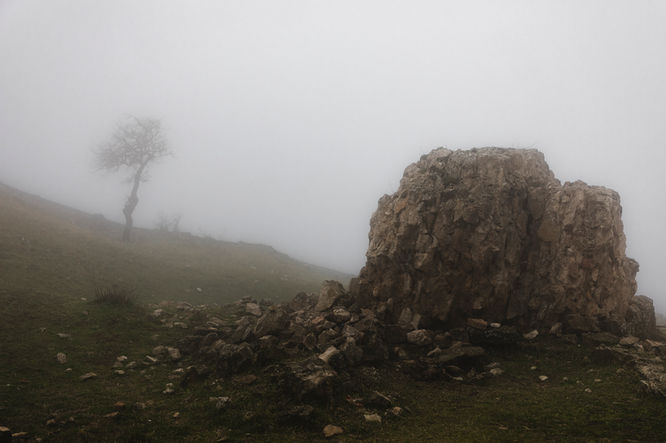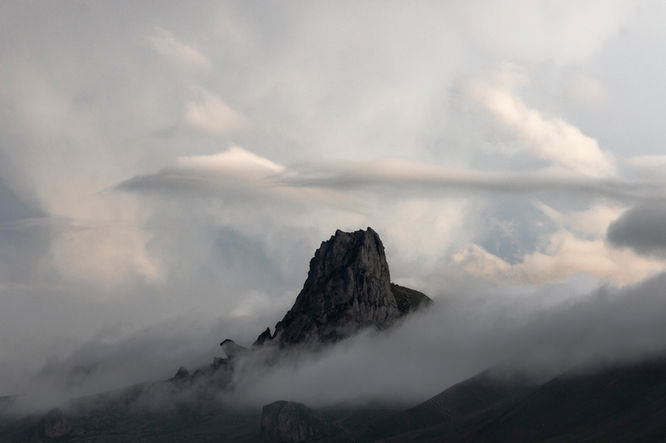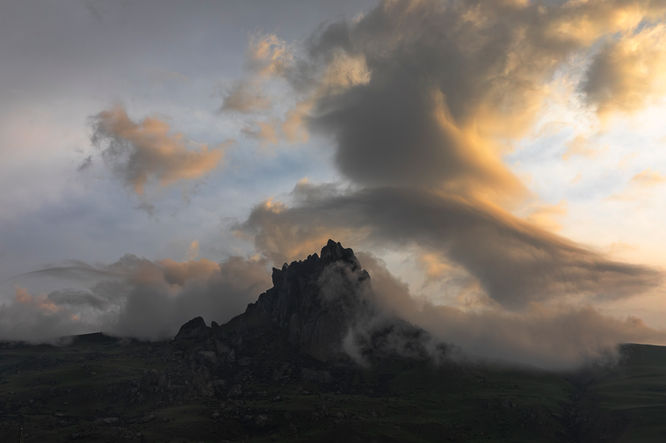
INTERVIEW
April 27, 2025
TRACES OF TIME
Photography by Zamin Jafarov
Interview by Melanie Meggs
Zamin Jafarov’s photography is a journey through light, time, and the human spirit. Over the past decade, this Azerbaijan-based photographer has cultivated a distinctive body of work that explores the intricate relationship between nature, humanity, and the ephemeral moments that define our lives. Zamin’s photographs reveal a quiet intensity. Whether capturing the solitude of remote mountain regions, the shifting geometry of urban life, or the fleeting gestures of a passerby, his photographs are filled with a sense of presence. There is no rush in his frames — only careful observation, patience, and an instinctive understanding of time as both subject and medium.
Zamin’s start into photography began in 2009, developing alongside a deep passion for mountaineering. Perhaps it’s this balance between movement and stillness, the climb and the pause, that informs his unique way of seeing.
Zamin’s photographic approach blurs the lines, not confining himself to a single genre — instead, it is a constantly evolving dialogue that spans street photography, metaphysical and abstract explorations, extreme photography, and the quiet power of new topographies. His photography reveals a meticulous attention to detail, using light and shadow not just as compositional tools, but as metaphors for the complexities of life itself. Zamin’s documentary photography further deepens this exploration, capturing raw, authentic moments of everyday life and offering a window into the lived experiences of individuals, cultures, and communities of Azerbaijan.
Marked by an ongoing visual dialogue with time, memory, and impermanence, Zamin’s long-term projects reveal the layers beneath everyday life, capturing those fleeting moments. He also likes to challenge the notion that the value of a photograph lies in the equipment, emphasizing instead the photographer's ability to uncover truth through their perspective. In his work, the viewer is invited to reflect on the changing nature of human existence and to discover the hidden beauty that often goes unobserved in our everyday surroundings.
Currently, Zamin is preparing his first photo book — a collection of images that spans ten years of work, highlighting the evolution of his photographic voice and his commitment to documenting both the immensity and the subtlety of life. As his career continues to unfold, Zamin remains dedicated to exploring how photography can convey deeper truths about the human experience, with each image telling a story not just of what is seen, but of what is felt.
In this conversation, we explore the heart of Zamin Jafarov’s vision, his process of capturing moments that reflect the passage of time, and the ways in which his photography questions traditional boundaries to create a visual language all its own.

“To me, photography and art carry this meaning: “The Earth without art is just...eh.” The core philosophy is about realizing the act of seeing, learning to observe, and recognizing. The world is rapidly changing, and in this change, within spaces, photographers live, travel, and capture moments. They spend years working, studying, observing, gaining experience, and changing their perspectives to frame just one moment out of the chaos. The key question is, “What do we see and what do we miss?”
IN CONVERSATION WITH ZAMIN JAFAROV
THE PICTORIAL LIST: How does your experience as a mountaineer influence the way you approach photography — both in terms of physical perspective and emotional mindset? Do you find that the rhythm of climbing mirrors the rhythm of observing and capturing a moment?
ZAMIN: That’s an interesting question. I started mountaineering with a photography project. In 2011, my photographer friends Zaur Mirzayev and Vusal Mustafayev and I launched a new project. We created a mountaineering group called “Photo Peak” and began mountaineering courses. It’s hard for me to express my connection to nature in words, just like with photography. When I engage in both activities, it’s true that I lose a lot of energy, but I enjoy the process, and even after many years, those moments remain in my memory, constantly giving me new inspiration, perspectives, and ways of thinking. Both activities require focus, patience, thought, the ability to see and observe, and choosing the right moment to take action, which creates an interesting harmony and rhythm. For me, nature and photography cannot be separated. Nature and mountains always draw me in, despite the challenges. And every time I return, I gain new experiences and a deeper love for life. And, of course, new photos, new work. Another interesting nuance I would like to mention as photographers know, the ideal time for an outdoor photoshoot is about an hour after sunrise and an hour before sunset. However, this rule doesn’t apply at altitudes above 3000 meters. Every moment on the mountain is different and full of surprises. Every photographer agrees that it is the surprises that make photography interesting. On the mountain, there are many shots that not everyone can access. True, shooting with heavy camera equipment, a mountain bag on your shoulder, in difficult terrain and weather conditions, is not easy. One must also consider the potential dangers to life. You have to measure everything carefully. You need to learn to shoot and also pay attention to your health. Sometimes, you wonder, “What am I doing here?” But over time, as you gain experience and continue with confidence, behaving with patience and caution, you carry on. When you return to the city, the many photos and unforgettable moments motivate you for the next trip.
TPL: What does home feel like to you, when you're deep in the mountains of Azerbaijan or walking through the old streets of Baku?
ZAMIN: For me, the word “home” means anywhere I feel happy. It’s the Earth. Whether I’m with my family, or in the city, taking photos, walking, or exploring, whether in the mountains or any village, it gives me a sense of belonging and being at home.
TPL: Your work speaks in quiet tones — patient, present, and observant. What draws you to stillness in a world that moves so fast?
ZAMIN: In a rapidly changing world, we need tranquility. Time passes, and we need photography as a way to slow down the pace of life, appreciate the moment, and recognize life itself. It helps us become aware of ourselves and not regret the time that has passed, so we can better appreciate the present and future.
TPL: You have described light and shadow as more than compositional tools — as metaphors. What do they represent to you personally?
ZAMIN: Photography is life, and light and shadow are essential elements of this life. Everything in life is dual: day and night, cold and hot, good and bad, etc. This dual system sometimes reflects our choices. It’s hard to appreciate one without the other. A picture with only light, without shadow, doesn’t seem as appealing. Like the contrasts in life, this is the core of photography. The main elements of composition are precisely these pairs. Photography comes alive with these dualities and gives contrast.
TPL: Why do you sometimes decide to photograph your projects entirely on a smartphone? How does that shift your perception or creative choices?
ZAMIN: In the past, film cameras were used, and photographers would think more carefully, using the 36 frames effectively. Nowadays, there are no limits, and it’s even possible to shoot with smartphones. This might bring a sense of laziness, but if used correctly, it’s an advantage. More photos need to be taken to develop faster and improve. Of course, theory must also be considered, and it should be done systematically, forming and finding the aesthetic. I love walking every day, and since my smartphone is always with me, I focused on development and flexibility, and started shooting with my smartphone, which offered unlimited versatility. This helped me think more about content, rather than technical aspects.
With my photos, I want to show moments that people might not notice or that they may not have seen, to make them feel what I feel, even if just a little.

TPL: Much of your work is a reflection on impermanence. Do you think photography has the power to hold onto time, or is it more about learning to let go?
ZAMIN: Photography combines both opposites. On one hand, it shows us a moment frozen in time, but on the other hand, it reminds us that that moment is already gone. For me, photography teaches us to capture the moment, to be present in it, and to appreciate it.
TPL: What have your long-term projects taught you about change — in landscapes, in people, and in yourself?
ZAMIN: Long-term projects teach you to see where we come from and where we’re going, to appreciate the rhythm of life, and to enjoy the long-term process. They teach patience and the importance of finding new stories within changing times and people.
TPL: Can you walk us through what’s typically in your photography bag? Are there tools or objects you never leave behind, even if they’re not technical?
TPL: As you prepare to release your first photo book, what do you hope viewers will take away from the experience of seeing your images in a collection versus individual prints or digital formats?
ZAMIN: Initially, I wanted the images to not only tell a story but to convey a narrative. Then, I moved away from this dualism. Now, I want the viewers to flip through the book, fall into a rhythm, and experience a mood, not just to look at the pictures. I want them to find enjoyment, peace, and calm when they view it.
I plan to present my first book, “Smart Frames”, at my first exhibition, “Traces of Time.” Therefore, the exhibition will feature both a section dedicated to the photos in the book, as well as other smartphone images that link 11 years of history under the title “Traces of Time.” I am currently seeking a sponsor for both the exhibition and the book’s printing. If successful, I would even be willing to hold the first presentation and exhibition outside Azerbaijan, at the sponsor’s request.
TPL: Where do you imagine yourself creatively in the next 3 to 5 years? Is there something you want to achieve in this time frame?
ZAMIN: In this period, I have new projects and plans to discover new approaches. I plan to focus more on exhibitions and books, and work on prints. I want to expand the boundaries of my photography.
TPL: When you’re not photographing or climbing mountains, what grounds you? What kinds of things bring you peace or inspiration?
ZAMIN: My main job is different. But one day I hope I will fully do only photography job. Photography, however, is as essential to me as air and water; it is my soul. Besides photography and mountaineering, I find inspiration in my family, being with them, being in nature, looking, observing, hiking, sports, music, books, exhibitions, meetings, sharing and receiving positive energy, communication, and many other elements that I haven’t mentioned.

Through Zamin Jafarov’s thoughtful reflections and evolving body of work, it becomes clear that his photography is more than a visual practice — it is a philosophy of living, seeing, and feeling. Whether navigating treacherous mountain paths or quietly observing city streets, Zamin invites us to pause, to look closer, and to find meaning in fleeting moments. His transition from “Traces of Time” to “Smart Frames” signals not a departure, but a deepening — a shift from narrative to pure visual poetry, where color, form, and composition speak on their own terms. As he prepares to launch his first photo book and exhibition, Zamin’s work highlights the quiet power of observation, the emotional depth of simplicity, and the enduring beauty found in the everyday. His images encourage us to ask not just what we see — but how we see.
The Pictorial List wishes Zamin every success with his forthcoming book and exhibition. We encourage our community to stand behind his inspiring new endeavor and celebrate the unique vision he continues to share with the world.














































